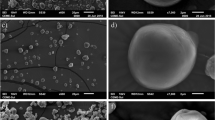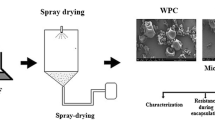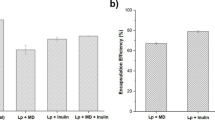Abstract
Freeze-dried banana powder represents an ideal source of nutrients and has not yet been used for probiotic incorporation. In this study, microencapsulation by freeze drying of probiotics Lactobacillus acidophilus and Lactobacillus casei was made using whey protein isolate (WPI), fructooligosaccharides (FOS), and their combination (WPI + FOS) at ratio (1:1). Higher encapsulation yield was found for (WPI + FOS) microspheres (98%). Further, microcapsules of (WPI + FOS) were used to produce a freeze-dried banana powder which was analyzed for bacterial viability under simulated gastrointestinal fluid (SGIF), stability during storage at 4 °C and 25 °C, and chemical and sensory properties. Results revealed that (WPI + FOS) microcapsules significantly increased bacteria stability in the product over 30 days of storage at 4 °C averaging (≥ 8.57 log CFU/g) for L. acidophilus and (≥ 7.61 log CFU/g) for L. Casei as compared to free cells. Bacteria encapsulated in microspheres (WPI + FOS) were not significantly affected by the SGIF, remaining stable up to 7.05 ± 0.1 log CFU/g for L.acidophilus and 5.48 ± 0.1 log CFU/g for L.casei after 90 min of incubation at pH 2 compared to free cells which showed minimal survival. Overall, encapsulated probiotics enriched freeze-dried banana powders received good sensory scores; they can therefore serve as safe probiotics food carriers.







Similar content being viewed by others
References
Shah NP (2007) Functional cultures and health benefits. Int Dairy J 17:1262–1277
Gibson GR, Roberfroid MB (1995) Dietary modulation of the human colonic microbiota – introducing the concept of prebiotics. J Nutr 125:1401–1412
Doleyres Y, Lacroix C (2005) Technologies with free and immobilized cells for probiotic bifidobacteria production and protection. Int Dairy J 15:973–988
Fu N, Chen XD (2011) Towards a maximal cell survival in convective thermal drying processes. Food Res Int 44:1127–1149
Hsu YL, Chu IM (1992) Poly(ethylenimine)-reinforced liquid-core capsules for the cultivation of hybridoma cells. Biotechnol Bioeng 40:1300–1308
Picot A, Lacroix C (2004) Encapsulation of bifidobacteria in whey protein-based microcapsules and survival in simulated gastrointestinal conditions and in yogurt. Int Dairy J 14:505–515
Guerin D, Vuillemard J, Subirade M (2003) Protection of bifidobacteria encapsulated in polysaccharide-protein gel beads against gastric juice and bile. J Food Prot 66:2076–2084
Ainsley Reid A, Champagne CP, Gardner N, Fustier P, Vuillemard JC (2007) Survival in food systems of Lactobacillus rhamnosus R011 microentrapped in whey protein gel particles. J Food Sci 72:31–37
Rajam R, Bharath Kumar S, Prabhasankar P, Anandharamakrishnan C (2015) Microencapsulation of Lactobacillus plantarum MTCC5422 in fructooligosaccharide and whey protein wall systems and its impact on noodle quality. LWT Food Sci Technol 52(7):4029–4041
Wang J, Zhi LY, Chen RR, Bao JW, Yang GM (2007) Comparison of volatiles of banana powder dehydrated by vacuum belt drying, freeze-drying and air-drying. Food Chem 104(4):1516–1521
Thompson Coon J, Ernst E (2002) Systematic review: herbal medicinal products for non-ulcer dyspepsia. Aliment Pharmacol Ther 16:1689–1699
Lee HM, Lee Y (2008) A differential medium for lactic acid-producing bacteria in a mixed culture. Lett Appl Microbiol 46:676–681
Rajam R, Karthik P, Parthasarathi S, Joseph G, Anandharamakrishnan C (2012) Effect of whey protein–alginate wall systems on survival of microencapsulated Lactobacillus plantarum in simulated gastrointestinal conditions. J Funct Foods 4:891–898
Dissanayake M, Vasiljevic T (2009) Functional properties of whey proteins affected by heat treatment and hydrodynamic high-pressure shearing. J Dairy Sci 92:1387–1397
Heidebach T, Först P, Kulozik U (2009) Transglutaminase-induced caseinate gelation for the microencapsulation of probiotic cells. Int Dairy J 19(2):77–84
Manica I (1997) Banana. Porto Alegre: Cinco Continentes. Frutic Trop 4:485
Aurore G, Parfait B, Fahrasmane L (2009) Bananas raw materials for making processed food products. Trends Food Sci Technol 20:78–91
Dubois M, Gilles KA, Hamilton JK, Rebers PA, Smith F (1956) Colormetric method for determination of sugars and related substances. Anal Chem 28:350–356
Miller GL (1959) Use of dinitrosalicylic acid reagent for determination of reducing sugar. Anal Chem 31(3):426–428
De Knegt RJ, Brink HVD (1998) Improvement of the drying oven method for the determination of the moisture content of milk powder. Int Dairy J 8:733–738
Van Slyke DD (1992) On the measurement of buffer values and on the relationship of buffer value to the dissociation constant of the buffer and reaction of the buffer solution. J Biol Chem 52:525–570
Jellinek G (1985) Sensory evaluation of food - theory and practice. Ellis Horwood Ltd. John Wiley and Son, Chichester England and VCH Verlagsgesellschaft mbh, Weinheim, p 218
Lian WC, Hsiao HC, Chou CC (2003) Viability of microencapsulated bacteria in simulated gastric juice and bile solution. Int J Food Microbiol 86:293–301
United States Pharmacopeia and National Formulary (2002) United States Pharmacopeial Convention Inc., Rockville, MD, USA, 25th edn
Agnihotri N, Mishra R, Goda C, Arora M (2012) Microencapsulation- a novel approach in drug delivery: a review. Indo Global J Pharm Sci 2:1–20
Bolla PA, de Serradell ML, de Urraza PJ, De Antoni GL (2011) Effect of freeze-drying on viability and in vitro probiotic properties of a mixture of lactic acid bacteria and yeasts isolated from kefir. J Dairy Res 78:15–22
Kaplan H, Hutkins RW (2000) Fermentation of fructooligosaccharides by lactic acid bacteria and bifidobacteria. Appl Environ Microbiol 66:2682–2684
Capela P, Hay TKC, Shah NP (2006) Effect of cryoprotectants, prebiotics and microencapsulation on survival of probiotic organisms in yoghurt and freeze-dried yoghurt. Food Res Int 39(2):203–211
Heidebach T, Först P, Kulozik U (2010) Influence of casein-based microencapsulation on freeze-drying and storage of probiotic cells. J Food Eng 98(3:309–316
Bielecka M, Biedrzycka E, Majkowska A (2002) Selection of probiotics and prebiotics for synbiotics and confirmation of their in vivo effectiveness. Food Res Int 35:139–144
Sanders ME, Marco MLF (2010) Food formats for effective delivery of probiotics. Annu Rev Food Sci Technol 1:65–85
Zou Q, Zhao JX, Liu XM, Tian FW, Zhang HP, Zhang H, Chen W (2011) Microencapsulation of Bifidobacterium bifidum F-35 in reinforced alginate microspheres prepared by emulsification/internal gelation. Int J Food Sci Technol 46(8):1672–1678
Ying D, Schwander S, Weerakkody R, Sanguansri L, Gantenbein-Demarchi C, Augustin MA (2013) Microencapsulated Lactobacillus rhamnosus GG in whey protein and resistant starch matrices: probiotic survival in fruit juice. J Funct Foods 5:98–105
Rius N, Sole M, Francia A, Lorén JG (1994) Buffering capacity and membrane H+ conductance of lactic acid bacteria. FEMS Microbiol Lett 120:291–296
Kailasapathy K, Masondole (2005) Survival of free and microencapsulated Lactobacillus acidophilus and Bifidobacterium lactis and their effect on texture of feta cheese. Aust J Dairy Technol 60:252–258
Shan NP, Jelen P (1990) Survival of lactic acid bacteria and their lactases under acidic conditions. J Food Sci 55:506–509
Van de Guchte M, Serror P, Chervaux C, Smokvina T, Ehrlich SD, Maguin E (2002) Stress responses in lactic acid bacteria. Antonie Van Leeuwenhoek 82(1–4):187–216
Chaikham P, Apichartsrangkoon A, Worametrachanon S, Supraditareporn W, Chokiatirote E, Van de Wiele T (2013) Activities of free and encapsulated Lactobacillus acidophilus LA5 or Lactobacillus casei 01 in processed Logan juices on exposure to simulated gastrointestinal tract. J Sci Food Agric 93(9):2229–2238
Charteris WP, Kelly PM, Morelli L, Collins JK (1998) Development and application of an in vitro methodology to determine the transit tolerance of potentially probiotic Lactobacillus and Bifidobacterium species in the upper human gastrointestinal tract. J Appl Microbiol 84:759–768
Corcoran BM, Ross RP, Fitzgerald GF, Stanton C (2003) Comparative survival of probiotic lactobacilli spray-dried in the presence of prebiotic substances. J Appl Microbiol 96:1024–1039
Funding
This work was supported by Applied Technology Research and Development Project of Harbin in 2017 (2017RAQXJ087).
Author information
Authors and Affiliations
Corresponding author
Ethics declarations
This article does not contain studies with human or animal subjects.
Conflict of Interest
The authors declare that they have no conflict of interest.
Rights and permissions
About this article
Cite this article
Massounga Bora, A.F., Li, X., Zhu, Y. et al. Improved Viability of Microencapsulated Probiotics in a Freeze-Dried Banana Powder During Storage and Under Simulated Gastrointestinal Tract. Probiotics & Antimicro. Prot. 11, 1330–1339 (2019). https://doi.org/10.1007/s12602-018-9464-1
Published:
Issue Date:
DOI: https://doi.org/10.1007/s12602-018-9464-1




